
4 Example AP US History Short Answer Questions
The short answer is one of the newer features of the APUSH exam, and at 20% of your overall APUSH score , you want to make sure you can tackle these questions with confidence. Use these 3 questions – and one student example – to help you study for the short answers on the APUSH exam.
What does a short answer question require me to do?
Taken from the APUSH website, a short answer question will have you:
1. Analyze historians’ interpretations, historical sources, and propositions about history. 2. Answer questions that may include texts, images, graphs, or maps. 3. Update for 2017-18 : The number of required short answer questions has been reduced to three, and the time allotted has been decreased to 40 minutes. Students will choose between two options for the final required short answer question, each one focusing on a different time period.
- Question 1 (required): periods 3-8
- Question 2 (required): periods 3-8
- Students choose between Question 3, periods 1-5, and Question 4, periods 6-9
Think of the short answer as an opportunity for you to do more of the historical thinking work that you have prepared to do.
Can you give me an example of past short answer questions?
I can do that and break down why the student got the score that they did.
The following example, and student response, is taken from the 2016 APUSH exam .
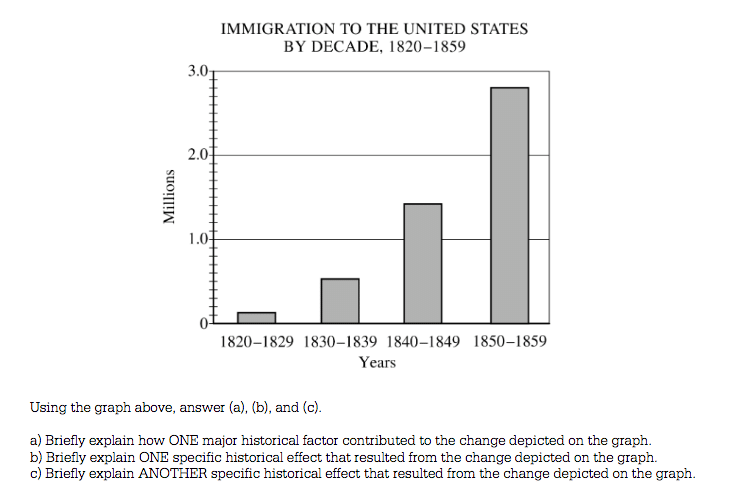
Let’s break this down a little bit.
For part (a), the question is asking you what contributed to the change shown on the graph – not what was the most important cause, or the major factor, but what contributed. This opens up a lot of possibilities for you! The graph is showing an exponential increase in immigration to the United States (notice the question isn’t asking for a specific part of the United States – score!) between 1820 and 1859.
Questions (b) and (c) are asking you to explain historical events that resulted from this increase in immigration; again, this is not requiring you to talk about an immediate result or the most significant, but just to explain events that resulted from the change depicted in the graph.
You can do both of these things. Let’s see how students responded.
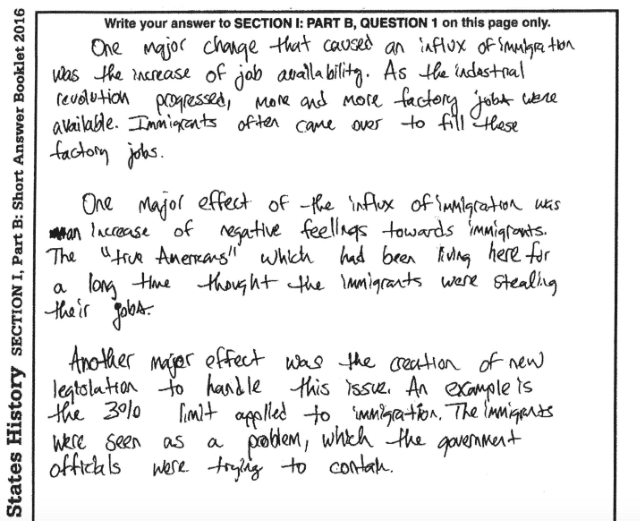
How well do you think this student addressed the three components in the question?
Did you get a little confused at the third response? After all, what is this 3% limit on immigration this student is responding to?
The APUSH exam graders agreed. As stated by the College Board, the makers of the APUSH exam, this student earned 1 point for part (a) – “This brief response earned a point for identifying that due to the Industrial Revolution “more and more factory jobs were available,” causing “an influx of immigration.” – 1 point for part (b) – “The response earned a point for…stating that “ ‘true Americans’” developed “negative feelings towards immigrants.” – but earned 0 points for part (c) – “No point was awarded for this response because it incorrectly asserts that a “3% limit applied to immigration” during this period.”
Let’s look at another example that got all 3 points.
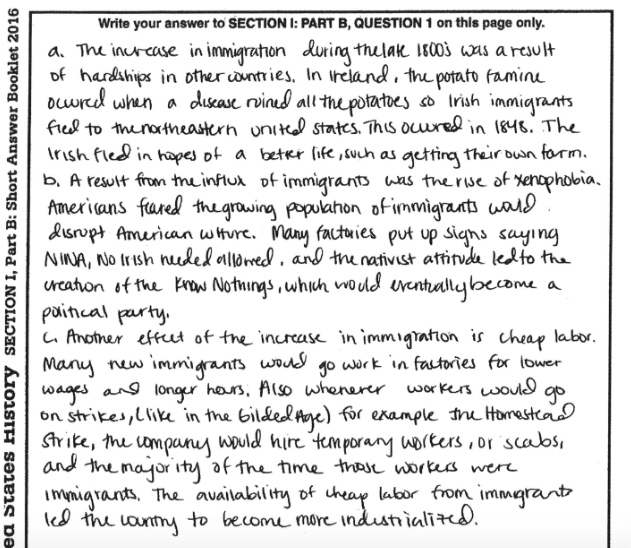
Your default assumption may be that this second response is longer, and therefore, it earned more points.
But that’s not what the APUSH scorers believed; after all, you only have 40 minutes. You need to be efficient in your responses.
They stated the following (again, from the College Board website):
(a) 1 point: This well-written response earned a point for identifying increased immigration in the given time period as a result of the potato famine in Ireland. (b) 1 point: The response earned a point as it connects xenophobia to the fear that “immigrants would disrupt American culture” thereby leading to the Know-Nothings. (c) 1 point: In spite of the reference to specific examples outside the period, the answer earned a point for noting that increased immigration made for “cheap labor.”
My point in showing you these two examples is to demonstrate that (1) being accurate, (2) writing clearly, and (3) referencing specifics are what the exam graders are looking for in responses. If you can do those three things, you will be well on your way to full credit for each short answer question.
3 Sample Short Answer Questions
Short answer 1.

Using the political cartoon, answer (a), (b), and (c) .
(a) Briefly describe ONE historical perspective that would support the ideas presented in this political cartoon. (b) Briefly describe ONE historical perspective that would contradict/disagree with the ideas presented in this political cartoon. (c) Describe ONE event that was the result of the event presented in this political cartoon.
Short Answer 2
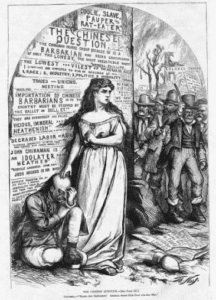
(a) Briefly describe ONE event or idea that Nast was responding to in this cartoon. (b) Briefly describe ONE way you know from the cartoon that this was published in a Northern magazine. (c) Briefly describe ONE outcome of the event or idea that is depicted in this cartoon.
Short Answer 3
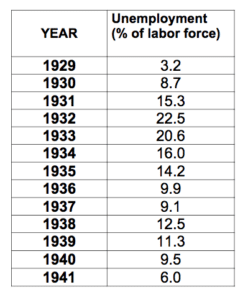
Using the table above, answer (a), (b), and (c) .
(a) Briefly describe ONE contributing factor to the unemployment rates depicted in this table. (b) Briefly describe ANOTHER contributing factor to the unemployment rates depicted in this table. (c) Briefly describe ONE reason for the falling unemployment rates in 1941.
Possible Response:
(a) This cartoon represents the perspective of a Northerner, or a free-soiler who opposed slavery’s expansion into western territory. They are likely responding to the Kansas-Nebraska Act of 1854. (b) Democrats, like Stephen Douglas, would likely disagree with the opinions presented in this political cartoon because they believed compromise over slavery was the way to keep the union together. (c) An obvious outcome of the tensions presented in this cartoon was the Civil War; a continuing outcome of the tensions could also be the conflict that has come to be known as “Bleeding Kansas.”
(a) Nast is responding to the finishing of the Transcontinental Railroad in 1869 that brought in an influx of Chinese immigrants and the xenophobic attitudes that Chinese workers endured as a result of their immigration. (b) This cartoon was published in a Northern magazine because the ruins of the Civil War and southern prejudice are depicted in the background. Nast is drawing a parallel between slavery and discrimination against Chinese workers. (c) The Chinese Exclusion Act of 1882 was an immediate outcome of the tensions described in this political cartoon.
(a) and (b) The unemployment rates depicted in this graph are the result of The Great Depression, the Dust Bowl, and the responses to those events in the form of the First and Second New Deals. (c) One reason for the falling unemployment rates in 1941 was the increase in wartime industry. The US supplied war materials to their allies before entering World War II in December 1941.

Allena Berry loves history; that should be known upfront. She loves it so much that she not only taught high school history and psychology after receiving her Master’s degree at Stanford University, she is now studying how students learn history at Northwestern. That being said, she does not have a favorite historical time period (so don’t bother asking). In addition to history, she enjoys writing, practicing yoga, and scouring Craigslist for her next DIY project or midcentury modern piece of furniture.
View all posts
More from Magoosh
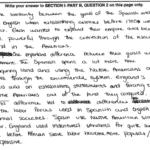
2 responses to “4 Example AP US History Short Answer Questions”
In Short Answer 3, Part (c), the answer should have the U.S. entering the war causing unemployment to go down in that year. The U.S. entered the war on 8 Dec 1941, which wouldn’t have much impact on the annual unemployment rate. The U.S. DID start selling military equipment to Britain and France in 1939, and this had an increasing impact on employment over the next three years.
Hi Randall,
Thanks for the comment! I agree that we didn’t capture this nuance effectively in our brief notes. I’m going to send this along to our blog writing team so that they can look it over 🙂
Leave a Reply Cancel reply
Your email address will not be published. Required fields are marked *

Choose Your Test
Sat / act prep online guides and tips, the ultimate guide to the ap us history exam.
Advanced Placement (AP)

The AP US History exam involves critical reading, writing, and in-depth analysis. It's not just about memorizing names and dates, but rather interpreting historical evidence quickly and accurately, recalling outside information on a topic, and synthesizing your ideas into a coherent argument.
In this guide, we'll give you a rundown of the format and structure of the AP US History test along with a brief content outline, sample questions, and some tips for a great score .
How Is the AP US History Exam Structured?
The next AP US History test will be administered on Friday, May 5, 2023, at 8 AM . This AP exam is three hours and 15 minutes long and consists of two main sections, each of which is divided into a Part A and a Part B.
Before we get into the details of each part, here's an overview of the US History test as a whole:
Section 1, Part A: Multiple Choice
The first section on the test is the multiple-choice section, which is worth 40% of your score and lasts for 55 minutes. You'll get 55 questions, each with four possible answer choices (labeled A-D); this means that you'll have about a minute per question on this part of the exam.
Most US History multiple-choice questions come in sets of three to four questions that require you to respond to certain stimuli, or sources, such as historical texts, graphs, and maps.
Section 1, Part B: Short Answer
Part B of Section 1 on the US History test requires you to answer three short-answer questions in 40 minutes , giving you about 13 minutes per question. It's worth 20% of your overall score.
The first two questions are required, but you get to choose between question 3 and question 4 for your third short answer . Here's what you can expect with each question:
Section 2, Part A: Document-Based Question
The Document-Based Question, or DBQ , is worth 25% of your final score and requires you to write an essay based on a prompt that's accompanied by seven historical documents . You'll get a 15-minute reading period followed by 45 minutes to write your response.
The DBQ will focus on a historical development in the years 1754-1980.
Section 2, Part B: Long Essay
The final part of the AP US History test is the Long Essay, for which you must choose one of three possible prompts and write an essay on the topic. You'll have 40 minutes to write your response, which will count for 15% of your overall AP score.
To earn full credit here, you must develop a clear and logical argument and support it with relevant historical evidence (which won't be directly provided to you as it will be on the DBQ).
Each of the three essay prompts revolves around a different time period in US history:
- Essay Prompt 1: 1491-1800
- Essay Prompt 2: 1800-1898
- Essay Prompt 3: 1890-2001
Content Background for the AP US History Exam
There are eight themes addressed in the AP US History course , and all of them show up in one form or another on the exam across the nine units, or time periods . Each represents a subset of learning objectives that students are expected to master. You can read more about these learning objectives in the AP US History Course and Exam Description .
Before I give you a broad overview of the eight themes, let's take a look at how the major units are weighted on the AP US History exam :
Below, we give you the definition of each course theme as described in the AP US History Course Description.
Theme 1: American and National Identity
Focuses on how and why definitions of American and national identity and values have developed among the diverse and changing population of North America as well as on related topics, such as citizenship, constitutionalism, foreign policy, assimilation, and American exceptionalism.
Theme 2: Work, Exchange, and Technology
Focuses on the factors behind the development of systems of economic exchange, particularly the role of technology, economic markets, and government.
Theme 3: Geography and the Environment
Focuses on the role of geography and both the natural and human-made environments in the social and political developments in what would become the United States.
Theme 4: Migration and Settlement
Focuses on why and how the various people who moved to and within the United States both adapted to and transformed their new social and physical environments.
Theme 5: Politics and Power
Focuses on how different social and political groups have influenced society and government in the United States as well as how political beliefs and institutions have changed over time.
Theme 6: America in the World
Focuses on the interactions between nations that affected North American history in the colonial period and on the influence of the United States on world affairs.
Theme 7: American and Regional Culture
Focuses on how and why national, regional, and group cultures developed and changed as well as how culture has shaped government policy and the economy.
Theme 8: Social Structures
Focuses on how and why systems of social organization develop and change as well as the impact that these systems have on the broader society.

Sample AP US History Questions
Now that you have a sense of the test content, I'll present you with sample questions to give you a better idea of what the AP US History exam actually looks like. All sample questions come from the official US History Course and Exam Description .
Sample Multiple-Choice Question
For multiple choice, you're given one or two pieces of historical evidence followed by a set of questions that ask you to do some analysis . The US History exam is less about knowing specific dates and names and more about being able to draw conclusions and connect themes based on materials provided by the test.
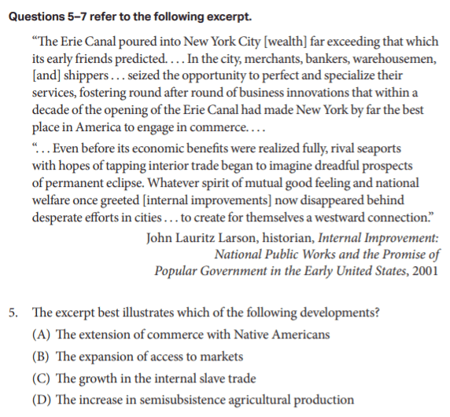
To answer this question, you don't even really need to know much about US history, as long as you pay attention to exactly what's written in the passage, or the secondary source you've been given. The passage here is mainly focused on the increase in commerce in New York as a result of the opening of the Erie Canal.
Answer choice A mentions commerce—that's a good sign—but specifically commerce with Native Americans, who are not mentioned at all in the passage, so this is unlikely to be the right answer.
Answer choice B discusses increased access to markets in the United States, which seems to echo what the passage says about commerce in New York. We'll hold onto this as a potential answer.
Answer choice C is all about the internal slave trade, which isn't mentioned at all in the secondary source, so we can assume this is wrong.
Answer choice D talks about agricultural production, which, again, isn't the focus of the passage—that's commerce. As a result, we can cross this off our list.
This means that the only logical answer to choose is answer choice B .
Looking for help studying for your AP exam?
Our one-on-one online AP tutoring services can help you prepare for your AP exams. Get matched with a top tutor who got a high score on the exam you're studying for!


Sample Short-Answer Question
The short-answer questions are technically considered part of the multiple-choice section because they're less involved than the essay questions. Alt hough they do have multiple parts, you don't have to come up with a thesis—one-sentence answers are OK. These questions are about succinctly connecting themes and reference materials to specific events or trends.
Here's an example:

This short-answer question is an example of question 1, which comes with two secondary sources. As you can see, you'll have to answer three separate parts (A, B, and C), each of which is worth 1 point ; this means you can earn up to 3 points for each short-answer question.
Here's how you could earn full credit for this sample question, per the official scoring guidelines .
(A) Sample Answers
- Peiss argues that pursuits of entertainment in dance halls by working class women created new, legitimate social spaces for women, however Enstand argues that working women's participation in labor politics gave them a new voice and place in the public sphere.
- Peiss links the growth of women in public social life to a commercial culture that provided opportunities for women to enter the public sphere while Enstand argues that women became political actors who demanded a public voice.
(B) Sample Answers
- Like the dance halls, department stores and amusement parks became aspects of the commercial culture that represented new opportunities for women to enjoy public places as legitimate participants.
- The concept of the New Woman became a cultural phenomenon, as the older idea of separate spheres diminished. The idea of the New Woman supported a more public role for women in the early 1900s.
- The growth of cities and urban America gave young women more opportunities to leave rural America and participate in the developments described by Peiss.
- New technologies such as electric lighting made possible new public spaces for personal freedom for women.
(C) Sample Answers
- Women's participation in the suffrage movement, settlement house work, temperance organizing, and the Progressive movement all contributed to modern attitudes about women and increased their roles in the public sphere.
- The ratification of the Nineteenth Amendment to the Constitution gave women the vote and a voice in politics.
- Women were the main participants in the New York shirtwaist strike of 1909. During this strike women made public demands like those described by Enstad.
- Women organized or participated in labor unions such as the International Ladies' Garment Workers' Union (ILGWU) which is an example of their growing voice in the public sphere.
- Working-class women had key public roles in the successful Lawrence (Massachusetts) textile strike of 1912, this demonstrates that women became active political voices through labor movements.

Sample Document-Based Question
With the DBQ , you'll have seven different historical documents to examine . To earn full credit, you must use at least six documents as evidence in your answer. These documents range from transcripts of folk songs, to excerpts from letters and newspapers, to demographic maps.
Here's an example of a DBQ (with one document shown):
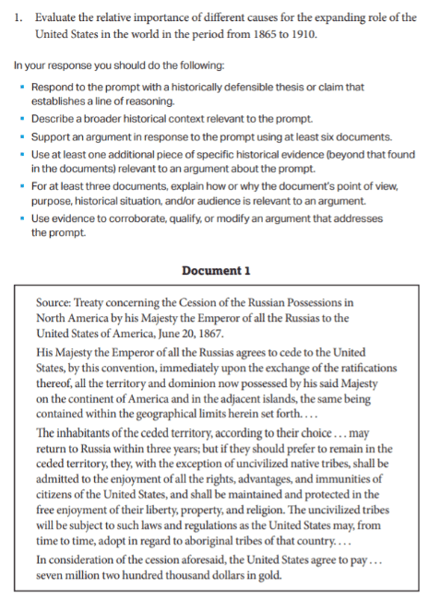
There are several components of a solid response to this question. The DBQ is worth a total of 7 raw points . Here's how you could earn full credit, according to the scoring guidelines .
Sample Long Essay Question
For the Long Essay, you must choose between three prompts . Here's an example of a potential prompt:
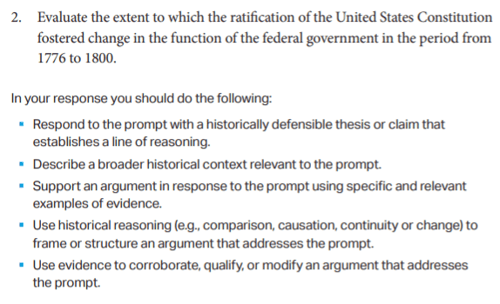
Your essay should include many of the same elements as your answer to the DBQ, but there are no documents to analyze and reference , so you'll have less time to write. The essay is worth 6 raw points .
Here's how you could earn full credit for the sample question above, per the scoring guidelines .
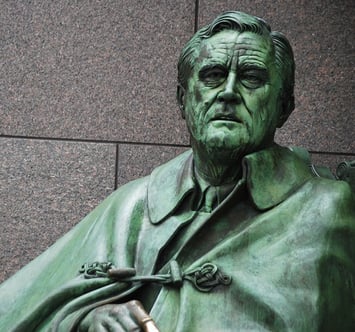
How Is the AP US History Exam Scored?
Here, we'll go over how each section on the AP US History exam is scored, scaled, and combined to give you your final AP score on the 1-5 scale .
On the multiple-choice section, you earn 1 raw point for each question you answer correctly; this means that the max score you can earn here is 55 points. No points are taken off for incorrect answers.
Each of the three short-answer questions is worth 3 points, so there are 9 points possible in this section.
The DBQ is scored out of 7 points and is based on the following criteria, per the scoring guide :
- Thesis/claim: 1 point
- Contextualization: 1 point
- Evidence from the documents: 2 points
- Evidence beyond the documents: 1 point
- Sourcing: 1 point
- Complexity: 1 point
Lastly, the Long Essay is out of 6 raw points and is scored using the following criteria:
- Evidence: 2 points
- Analysis and reasoning: 2 points
On essay questions, points are taken off for errors only if they detract from the quality of the argument being made (in other words, don't go making up historical facts to support your argument). Grammatical and other technical errors aren't a big deal as long as they don't inhibit the grader's ability to understand what your essay is saying.
The total number of raw points you can earn on the AP US History test is 77:
- 55 points for the Multiple Choice questions
- 9 points for the Short Answer questions
- 7 points for the DBQ
- 6 points for the Long Essay
Raw scores can be converted to scaled scores out of 150 . Here's how to do that for each section:
- Multiple Choice: Multiply your raw multiple-choice section score out of 55 by 1.09
- Short Answer: Multiply your raw short-answer score out of 9 by 3.33
- DBQ: Multiply your raw DBQ score out of 7 by 5.36
- Long Essay: Multiply your raw Long Essay score out of 6 by 3.75
Finally, add all the scores together to get your final scaled AP score for US History! Here is a chart to show you approximately how these scaled scores translate to final AP scores:
Source: The College Board
I made my best estimates based on other AP score conversion charts because there was no official scaled-to-AP-score conversion chart online for US History. Your AP teacher or review book might have a more accurate score conversion system you can use for official practice tests.
4 Essential Tips for Acing the AP US History Exam
AP US History is a grueling test that requires intense critical thinking and analytical skills. Here are some helpful tips to remember if you hope to do well on test day.
#1: Don't Confuse Accurate Facts for Correct Answers
Many multiple-choice questions will list answers that are accurate representations of historical events or trends but that don't directly respond to the question being asked . Be wary of these answers on the test so you don't accidentally choose them over more relevant responses.
In the multiple-choice question I gave above as an example, one incorrect choice was "The growth in the internal slave trade." At the time referenced in the question, this was a real trend that occurred, but because it doesn't relate directly to the passage given, it's still the wrong answer .
Don't let these types of answer choices confuse you; adhere to the particulars of the question and the evidence presented to you!
#2: Pay Attention to Details—Read Excerpts Carefully
Most of this AP exam is based on historical reference materials, meaning that you won't be able to answer questions correctly without reading carefully. Even if you know everything there is to know about US History, that knowledge will mostly just serve to contextualize the evidence presented on the test. The specific details found in the writings and images will ultimately reveal the best answer choice.
#3: Plan Before You Write
It's critical to write well-organized, focused essays on the AP US History test. A clear thesis is the first thing on the agenda. You then need to make sure that the rest of your essay ties back into your thesis and provides relevant evidence throughout. If you jump into writing an essay without taking the time to organize your thoughts, you're more likely to ramble or get off-topic from the main focus of the question.
For the DBQ, you should spend 15 of the 60 minutes planning how to organize your thoughts and how to use the different documents as evidence. While you will have less time for the Long Essay, you should still spend five minutes or so writing a brief outline before starting your final draft.
#4: Use Outside Evidence Wisely
It's a smart idea to incorporate additional background knowledge into your DBQ and Long Essay responses on the AP US History test. It shows that you've mastered the material and can connect themes to what you learned in class and not just what was presented to you in the question.
That said, don't include outside knowledge unless it really bolsters your argument . If you're just sticking it in there to prove how much you know, your essay will lack focus and you might lose points.
This is why it's so important to plan ahead. In the planning stage, you can think of examples that tie into your thesis and strategically place them throughout your essay in ways that contribute to your point.

Conclusion: Getting a Great Score on the AP US History Exam
The AP US History exam is one of the longer AP tests, and it has four different types of questions: Multiple Choice, Short Answer, Document-Based Question (DBQ), and Long Essay.
The main thread running through this test is an emphasis on analyzing historical evidence and applying outside knowledge in context. In your studying, you will need to learn to connect the themes of the course to events spanning 500 years of US history.
Here are some study tips to heed as you prep for the AP US History test:
- Don't mistake accurate facts for correct answers
- Always read excerpts carefully
- Plan before writing your essays
- Use outside evidence strategically
Make sure that you practice all the different types of exam questions with official materials before you sit down to take the real test . If you get used to thinking about history in an analytical, evidence-based context, you should have no problem earning a high US History score!
What's Next?
Looking for more practice materials? Check out our article on the best online quizzes you can take to prepare for the AP US History test !
Review books can be extremely helpful tools in preparing for AP exams. If you can't decide which one to get, take a look at this list of the best review books for the AP US History test .
Did you lose some of your notes? Feel free to use these links to AP US History notes for every section of the course .

Want to build the best possible college application?
We can help. PrepScholar Admissions is the world's best admissions consulting service. We combine world-class admissions counselors with our data-driven, proprietary admissions strategies . We've overseen thousands of students get into their top choice schools , from state colleges to the Ivy League.
We know what kinds of students colleges want to admit. We want to get you admitted to your dream schools .
Learn more about PrepScholar Admissions to maximize your chance of getting in.

Samantha is a blog content writer for PrepScholar. Her goal is to help students adopt a less stressful view of standardized testing and other academic challenges through her articles. Samantha is also passionate about art and graduated with honors from Dartmouth College as a Studio Art major in 2014. In high school, she earned a 2400 on the SAT, 5's on all seven of her AP tests, and was named a National Merit Scholar.
Student and Parent Forum
Our new student and parent forum, at ExpertHub.PrepScholar.com , allow you to interact with your peers and the PrepScholar staff. See how other students and parents are navigating high school, college, and the college admissions process. Ask questions; get answers.

Ask a Question Below
Have any questions about this article or other topics? Ask below and we'll reply!
Improve With Our Famous Guides
- For All Students
The 5 Strategies You Must Be Using to Improve 160+ SAT Points
How to Get a Perfect 1600, by a Perfect Scorer
Series: How to Get 800 on Each SAT Section:
Score 800 on SAT Math
Score 800 on SAT Reading
Score 800 on SAT Writing
Series: How to Get to 600 on Each SAT Section:
Score 600 on SAT Math
Score 600 on SAT Reading
Score 600 on SAT Writing
Free Complete Official SAT Practice Tests
What SAT Target Score Should You Be Aiming For?
15 Strategies to Improve Your SAT Essay
The 5 Strategies You Must Be Using to Improve 4+ ACT Points
How to Get a Perfect 36 ACT, by a Perfect Scorer
Series: How to Get 36 on Each ACT Section:
36 on ACT English
36 on ACT Math
36 on ACT Reading
36 on ACT Science
Series: How to Get to 24 on Each ACT Section:
24 on ACT English
24 on ACT Math
24 on ACT Reading
24 on ACT Science
What ACT target score should you be aiming for?
ACT Vocabulary You Must Know
ACT Writing: 15 Tips to Raise Your Essay Score
How to Get Into Harvard and the Ivy League
How to Get a Perfect 4.0 GPA
How to Write an Amazing College Essay
What Exactly Are Colleges Looking For?
Is the ACT easier than the SAT? A Comprehensive Guide
Should you retake your SAT or ACT?
When should you take the SAT or ACT?
Stay Informed
Get the latest articles and test prep tips!
Looking for Graduate School Test Prep?
Check out our top-rated graduate blogs here:
GRE Online Prep Blog
GMAT Online Prep Blog
TOEFL Online Prep Blog
Holly R. "I am absolutely overjoyed and cannot thank you enough for helping me!”
If you're seeing this message, it means we're having trouble loading external resources on our website.
If you're behind a web filter, please make sure that the domains *.kastatic.org and *.kasandbox.org are unblocked.
To log in and use all the features of Khan Academy, please enable JavaScript in your browser.
AP®︎/College US History
Course: ap®︎/college us history > unit 10, ap us history periods and themes.
- AP US History multiple choice example 1
- AP US History multiple choice example 2
- AP US History short answer example 1
- AP US History short answer example 2
- AP US History DBQ example 1
- AP US History DBQ example 2
- AP US History DBQ example 3
- AP US History DBQ example 4
- AP US History long essay example 1
- AP US History long essay example 2
- AP US History long essay example 3
- Preparing for the AP US History Exam (5/4/2016)
- AP US History Exam Prep Session (5/1/2017)
AP US history periods and themes
Example ap us history problems, key terms, documents, and court cases to know, primary documents:.
John Winthrop, “City on a Hill” / “A Model of Christian Charity”
Jonathan Edwards, “Sinners in the Hands of an Angry God”
Thomas Jefferson, “Declaration of Independence”
James Madison, “Constitution of the United States”
Elizabeth Cady Stanton and Susan B. Anthony, “Declaration of Sentiments”
Frederick Douglass, “What to the Slave is the Fourth of July?”
Harriet Beecher Stowe, “Uncle Tom’s Cabin” (main ideas)
Abraham Lincoln, “House Divided” speech, Second Inaugural Address
Sojourner Truth, “Ain’t I a Woman?”
Andrew Carnegie, “The Gospel of Wealth” (main ideas)
Josiah Strong, “Our Country” (main ideas)
Upton Sinclair “The Jungle” (main ideas)
Franklin Delano Roosevelt, First Inaugural Address, December 8 1941 address
George Kennan, “Long Telegram”
Martin Luther King Jr. “Letter from Birmingham Jail”, “I Have a Dream” speech
Betty Friedan “The Feminine Mystique” (main ideas)
Ronald Reagan “Evil Empire” speech
Supreme Court cases:
Marbury v. Madison
Dred Scott v. Sanford
Plessy v. Ferguson
Brown v. Board of Education
Roe v. Wade
Bush v. Gore
Foreign policy doctrines:
Monroe Doctrine
Roosevelt Corollary to the Monroe Doctrine
Truman Doctrine
Nixon Doctrine
Bush Doctrine
virgin soil epidemic
salutary neglect / benign neglect
mercantilism
Anti-Federalist
isolationism
judicial review
Democratic-Republican
Jacksonian Democracy
nullification
popular sovereignty
Emancipation
Jim Crow segregation
sharecropping
mass production
labor union
imperialism
self-determination
prohibition
laissez-faire economics
liberalism (economics/politics)
Soviet Union
containment
Domino Theory
non-violent protest (Civil Rights)
Vietnamization
conservatism
Want to join the conversation?
- Upvote Button navigates to signup page
- Downvote Button navigates to signup page
- Flag Button navigates to signup page


IMAGES
VIDEO
COMMENTS
Download free-response questions from past exams along with scoring guidelines, sample responses from exam takers, and scoring distributions. If you are using assistive technology and need help accessing these PDFs in another format, contact Services for Students with Disabilities at 212-713-8333 or by email at [email protected]. The ...
The short-answer part of the AP US History Exam, which appears after the multiple choice questions, consists of four questions—and you must answer three. Unlike the DBQ and LEQ later in the exam, your response to each short-answer question will be a brief, to-the-point answer to each question's three required tasks.
These sample exam questions were originally included in the AP U.S. History Curriculum Framework, published in fall 2012. The AP U.S. History Course and Exam Description, which is out now, includes that curriculum framework, along with a new, unique set of exam questions. Because we want teachers to have access to all available questions that ...
Format of AP U.S. History SAQ section. On the AP U.S. History exam, the first free response questions you will answer are the short answer questions. You have 40 minutes to complete this section of the exam. You should spend approximately 15 minutes on each question (5 minutes on each subpart). Each SAQ is divided into three parts.
Directions: Answer Question 1 and Question 2. Answer either Question 3 or Question 4. Write your responses in the Section I, Part B: Short-Answer Response booklet. You must write your response to each question on the lined page designated for that response. Each response is expected to fit within the space provided.
Contains 17 multiple-choice questions, one short-answer question, one DBQ, and one Long Essay prompt. 2017-18 Course and Exam Description: Mostly updated for current exam format. Contains the same questions as those in the 2017 practice test linked above. There is also this document with sample questions from the 2012 AP US History curriculum ...
Video transcript. - [Voiceover] So this video is about the short answer section on the AP U.S. history exam. So this is a real practice problem from the AP exam and I'd like to go through it step-by-step with you to give you an idea of how to approach these problems really well. So each of the short answer problems is three questions long and ...
2022 College Board. Visit College Board on the web: collegeboard.org. AP® United States History 2022 Scoring Commentary. Short Answer Question 2 (continued) The response to part (c) did not earn a point because the discussion of the North's "moral duty" does not explain how this development relates back to the excerpt and the claim ...
In the short-answer section, you'll write answers to questions in your test booklet. Some questions include texts, images, graphs, or maps. Question 1 is required, includes 1-2 secondary sources, and focuses on historical developments or processes between the years 1754 and 1980.
Scoring Guide. 0-3 points. Score 3 Response accomplishes all three tasks set by the question. Score 2 Response accomplishes two of the tasks set by the question. Score 1 Response accomplishes one of the tasks set by the question. Score 0 Response accomplishes none of the tasks set by the question.
Taken from the APUSH website, a short answer question will have you: 1. Analyze historians' interpretations, historical sources, and propositions about history. 2. Answer questions that may include texts, images, graphs, or maps. 3.
2019 AP ® US HISTORY FREE-RESPONSE QUESTIONS . Question 3 or 4 . Directions: Answer . either . Question 3 . or . Question 4. 3. Answer (a), (b), and (c). Confine your response to the period from 1607 to 1754. a) Briefly describe one difference between the economy of British North American colonies in the Chesapeake
The AP US History exam is one of the longer AP tests, and it has four different types of questions: Multiple Choice, Short Answer, Document-Based Question (DBQ), and Long Essay. The main thread running through this test is an emphasis on analyzing historical evidence and applying outside knowledge in context.
2018 AP US HISTORY® FREE-RESPONSE QUESTIONS UNITED STATES HISTORY SECTION I, Part B Time—40 minutes . Directions: Answer Question 1 and Question 2. Answer either Question 3 or Question 4. Write your responses in the Section I, Part B: Short-Answer Response booklet. You must write your response to each
Short Answer Question 1. Answer (a), (b), and (c). Briefly explain how ONE specific historical development represents an accomplishment of the national government under the Articles of Confederation. Briefly explain ONE specific argument critics used in the 1780s to support revising the Articles of Confederation.
Ambika Nuggihalli. 7 years ago. A) One example of change in Native American society due to contact with Europeans was the Columbian exchange, which introduced horses to Native Americans, effectively revolutionizing the way they hunted, traveled, and traded. C) One form of resistance against change brought by European contact was disease mourning.
We've put together some video examples of how to tackle each section of the AP US history exam. Find them here: Multiple choice section: How to approach multiple choice questions. Short answer section: How to approach short answer questions. Document-based essay: How to approach the DBQ. Long essay: How to approach the long essay question/LE.
AP® United States History 2021 Scoring Commentary Short Answer Question 2 Note: Overview • In response to this question, students were expected to demonstrate understanding of and analyze a primary source image depicting the role of women in the labor force during the Second World War. • Responses needed to describe a historical situation ...
Study with Quizlet and memorize flashcards containing terms like 1. What were the primary causes of industrial growth in the US in 2nd half of the 19th century? What good and bad outcomes arose because of the growth?, 2. How did the railroads develop in the 2nd half of the 19th century? What was the particular contribution of Vanderbilt and Gould? Why was this good or bad for the consumer?, 3 ...
The AP U.S. History Exam contains a short answer section to cover the skills of analyzing historical sources using argumentation, causation, and comparison and address all periods in the course ...
Exam questions assess the course concepts and skills outlined in the course framework. For more information, download the AP U.S. History Course and Exam Description (CED). Scoring rubrics - general scoring criteria for the document-based and long essay questions, regardless of specific question prompt - are available in the course and exam description (CED).
AP® United States History 2021 Scoring Commentary. Short Answer Question 3. Note: Overview. • This question asked students to describe the continuity and change in the relationship between the United States and American Indians from 1776 to 1815. • This question also asked students to describe a historical development that occurred between ...
The AP® US History (APUSH) exam consists of two primary sections. Section I includes both multiple-choice questions (MCQs) and short-answer questions (SAQs).Section II consists of free-response questions (FRQs), which include document-based questions (DBQs) and long essay questions (LEQs).. APUSH MCQs can be challenging because they emphasize historical reasoning rather than rote memorization.